How to Read a Unisource Pocket Micrometer
Micrometer Reading, Apply, and Measurement
When a pair of calipers only isn't authentic enough (i.e. need to measure a tolerance that is less than 0.002″), almost machinists volition turn to a Micrometer Reading. Micrometers come in digital, dial, and vernier styles, much like calipers:

Mitutoyo Digital Micrometer…
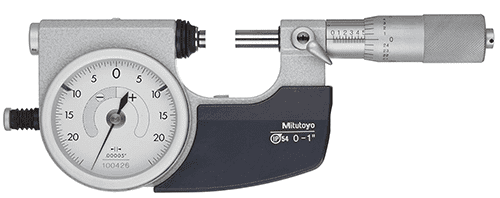
Mitutoyo Punch Micrometer, more than properly an Indicating Micrometer…
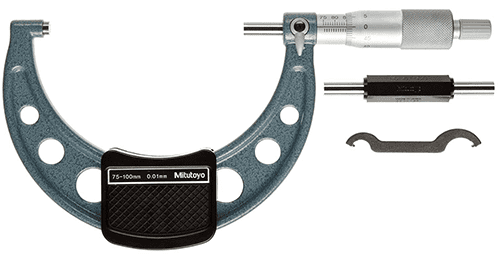
Mitutoyo Vernier Micrometer
Which Kind for Me?
Let's put bated the dial or indicating micrometer mode. They're very expensive and y'all may not even meet one outside a well-equipped Metrology Lab. Their purpose is to reduce operator error even more than than the ratcheting thimble volition. Turn until the dial is nix for the highest repeatability. They also have a quick release push button to minimize contact wear. If you really need highly accurate and repeatable measurements, and you lot need a lot of them, buy an indicating micrometer. Only, as I say, they are expensive!
That just leaves digital or vernier. If you can read the vernier quickly, hands, and accurately (it takes a footling practice), they're a lot cheaper, more durable, and the battery never goes dead considering they don't need a bombardment.
On the other hand, if you've never learned or gotten comfortable with vernier micrometers, you can get a micrometer reading from a digital at a glance. My preference is to keep digital for the sizes I apply the well-nigh and I bought a boxed set of vernier mics for larger sizes that I inappreciably e'er use.
Micrometer Sets & Size Ranges
Micrometers work using a precision spiral that moves the anvils together or autonomously. As such they take a fairly limited range of measurements they tin can take. It'due south common to take boxed Micrometer Sets so that you can take micrometer readings for a wide range of sizes.
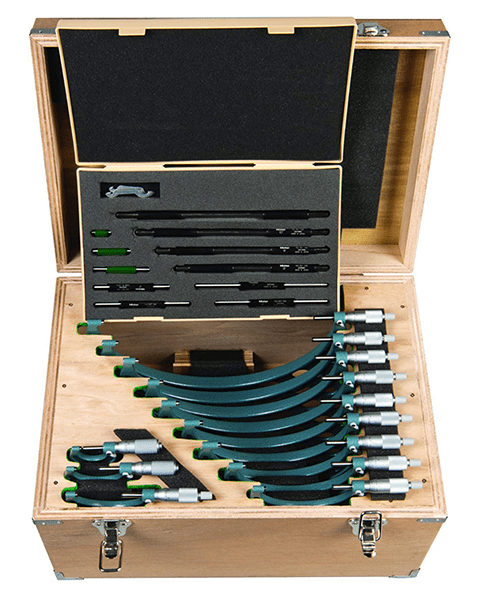
Mitutoyo Vernier Micrometer Set up, Sizes 0-12″
Pictured is a set up of Mitutoyo Vernier Micrometers with a combined range from 0-12″. A fix like this ane is quite expensive–$2141.seventy on Amazon equally I write this.
On the other hand, a somewhat lesser brand similar Fowler offers a set from 0-6″ of Vernier Micrometers for but $311.46. For merely a piffling more than, you tin even become a 0-6″ set of Digital Micrometers. Available on Amazon from iGaging for $395.00.
Reading a Vernier Micrometer
The best way to learn to read a Vernier Micrometer is by watching someone else explain it. Hither'due south a dandy video from Mitutoyo on micrometer reading for vernier mics:
Extra Credit: Would you lot like to practice micrometer reading with a vernier mic? Try this first-class simulation:
Virtual Micrometer – Thousandth of Inch Simulator
Micrometer Accuracy
Micrometers are mostly considered accurate downwardly to a tenth or 0.0001″. That's about every bit authentic as any CNC'er needs to measure except on very specialized projects. Something to go on in mind though:
Accuracy below 0.001″ is highly susceptible to temperature issues. Don't acquit your micrometer in your pocket–your body heat will warm it up and change the micrometer reading. Exist aware of the temps in your store where y'all are taking measurements. Consider using a Micrometer Stand (see below) which also helps keep your body estrus from affecting the micrometer reading.
Check out G-Magician'southward Termal Expansion Calculator (mentioned above) to get an idea of how much temperature can thing. BTW, just sign upward for the complimentary trial and you get to keep and use many of the calculators, including the Thermal Expansion Calculator, for life.
Micrometer Stand
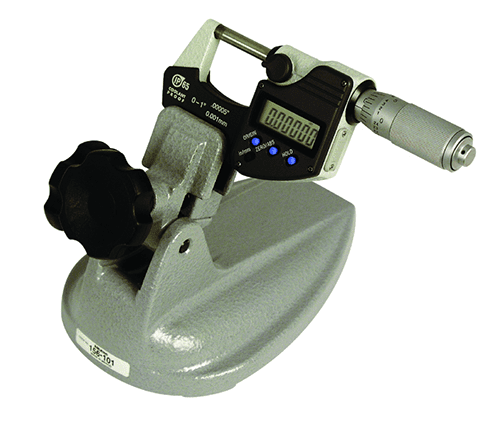
A Micrometer Stand up can lead to more than accurate measurement. It avoids transfering your body heat to the Micrometer, and makes it easier to take a measurement without juggling.
How to Employ a Micrometer (Ratchets for the win!)
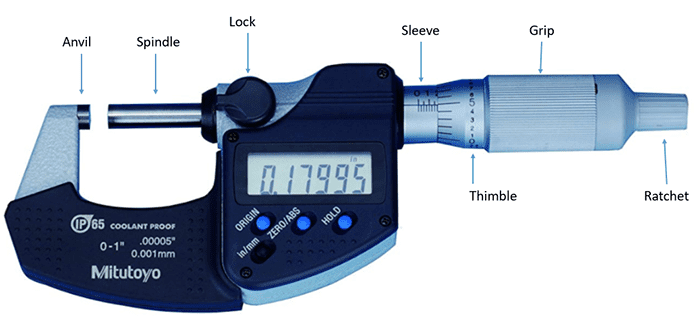
We saw above how to read a Vernier Micrometer. Aside from that skill, the two fundamental things about using a micrometer are keeping the object you're measuring parallel to the anvils and applying fifty-fifty consistent forcefulness to the micrometer when you lot take the measurement.
Just like Calipers, yous tin can forcefulness the measurement by applying as well much torque to the micrometer. One way to ensure consequent measurements is to become a Ratchet Thimple. This is a piffling built-in torque wrench. Turn the fiddling ratchet handle that sticks out of the main handle until it clicks a few times and you'll be taking your measurement with the same torque every time.
Micrometer Standards & Micrometer Scale
Given the level of precision most Micrometers bring, they demand calibration to ensure their accuracy. Authentic Calibration is so important that at that place is an actual standard describing how it should be done.
Here's generally how to calibrate a Micrometer:
- Make sure everything is working well with no bounden or other issues.
- Make clean the mic anvils
- Close it upwardly, zero information technology, and brand sure it reliably returns to zero.
- Now check the micrometer at various test points using gage blocks or other standards that are known to be highly accurate.
- For each test point, clean your gage blocks so there can be no debris or dust trapped between the block and the mic.
- Take several readings for each test point. Verify the micrometer repeats within the spec of its tolerance (east.g. 0.00005″). Note the measurements on a exam sheet that gives length, tolerance, measured length, and mistake.
- Yous should also bank check the flatness and parallelism of the anvils. Use a small-scale sphere, or the stylus of a digital probe. Set nix with the sphere in the centre of the anvil faces and nil. Motion the ball around the measuring faces and come across how the zeroed measurement changes. It must stay within the micrometer's tolerance.
Larger micrometers come with Micrometer Standards. These are precision rods that are bully for zeroing on the shop floor. They're not recommended for actual calibration considering they're not accurate enough.
Pictures are worth a yard words, so hither is a great video from Mitutoyo on calibrating your micrometers:
Nigh micrometers include a small spanner wrench that can be used to set the device to zero if it isn't reading zip when fully closed (perchance on a standard for larger mics)
Micrometer History
Interestingly, the first micrometer-like devices go all the style back to the 17th century where William Gascoigne used them to measure distances betwixt stars and besides to determine the relative sizes of various angelic bodies. Information technology wasn't until the early 19th century that Henry Maudslay built the start demote micrometer to serve as the final judge of measurement and accuracy.
By 1844, the details of Whiteworth's workshop micrometer were published, and it sounds very similar to modern micrometers. It had a cast iron frame and steel cylinders that opposed. One was driven by a precision screw and a dial that allowed measurements to a ten thousandth of an inch. Past 1867 Brown & Sharpe was mass producing them, which allowed the boilerplate machine shop to profoundly increase the accurateness of their measurements.
Special Types of Micrometer
Outside Micrometer
The most common micrometers, and the ones we've been discussing above are Exterior Micrometers. They measure outside dimensions.
Micrometer Head
Y'all may run across a Micrometer Caput that is part of some other instrument, or not fastened to a frame. This is mutual. They're useful as precision adjustments and stops, and as components in more complex equipment.
Inside Micrometer
Just as calipers can be used to measure out inside dimensions, y'all can purchase micrometers set up for it. They're called within micrometers:
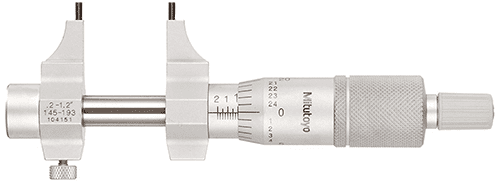
Mitutoyo 0.2-1.two″ Within Micrometer, Caliper-style. About $216.95 on Amazon.
The two little tips sticking up are round.
The 1 pictured is the "Caliper-Style." You tin too go Tubular Inside Micrometers.
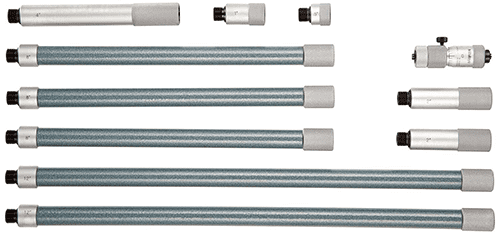
Tubular Inside Micrometers are less commonly seen, but handy for larger openings.
Blade Micrometer
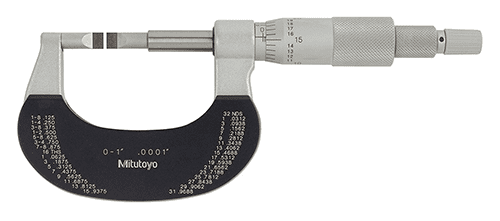
Blade Micrometers can be used to mensurate the outside dimensions of grooves.
Groove Micrometer

Hither's an odd creature, only where at that place's a tolerance there will be a corresponding measuring device. The Groove Micrometer uses concentric rods that have discs affixed. Put one disc in each groove or perhaps ane in a groove and one in an outside edge or face and y'all can mensurate how far autonomously they are with groovy precision.
Micrometer Depth Gage
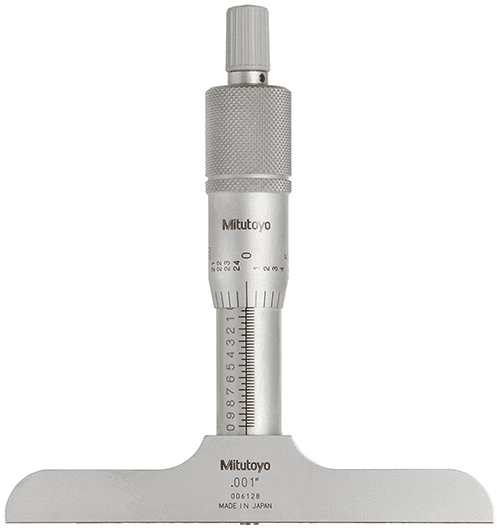
Nosotros saw in the section on Calipers how they have a depth cuff characteristic. Information technology should come as no surprise that when there's a need for more accurate depth readings, there is a micrometer to the rescue: introducing the Micrometer Depth Gage.
Bore Measuring Micrometer (Bore Micrometer)
Bores are such a scientific discipline unto themselves, I will wait until the diameter measuring section to talk virtually Diameter Micrometers.
Screw Thread Micrometer: See Metrology / Thread Measuring Tools
[ Return to Our Complete Metrology Guide ]
Join 100,000+ CNC'ers! Get our latest blog posts delivered straight to your email inbox once a week for gratuitous. Plus, we'll give you access to some great CNC reference materials including:
Source: https://www.cnccookbook.com/micrometer-reading-use-measurement/
0 Response to "How to Read a Unisource Pocket Micrometer"
Postar um comentário